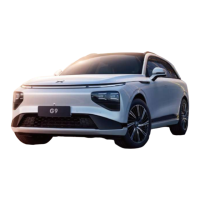intervene in lane departure appropriately, for
example:
• Dark (poor light) or poor visibility (due to
heavy rain, heavy snow, heavy fog, and others).
• When the hard light (for example the headlamp
light or the direct sunlight) interferes with the
camera's field of view.
• The camera’s field of view is blocked by the
preceding vehicles.
• The camera’s field of view (blocked by water
mist, dust, or sticker) is blocked by the
windscreen.
• Excessive wear of lane lines, overlapping old
and new lane markings, or temporary road
adjustments due to construction or rapid
changes (e.g., lane forks, crossings, or merges)
• Objects or landscape features are casting
strong shadows on the lane.
• Strong lateral airflows or strong winds on one
side of the vehicle can affect the performance
of lane departure assistance. It is not suitable
to use this feature in such weather conditions.
Lane departure assistance may miss warnings
and interventions or issue incorrect warnings and
interventions in the following situations:
• The camera is subject to the limit. See 20
page
• Weather conditions (heavy rain, snow, fog,
extreme heat, or cold) affect camera operation.
Please note that the provided examples,
warnings, and limitations do not cover all
situations that may impact the normal operation
of lane departure assistance.
,QWHOOLJHQW+LJK%HDP&RQWURO,+%
)XQFWLRQ,QWURGXFWLRQ
The IHB function automatically switches between
high and low beams based on information such
as oncoming vehicles and ambient lighting to
avoid disturbing other traffic participants.
$FWLYH6DIHW\
85
4
https://www.automotive-manuals.net

